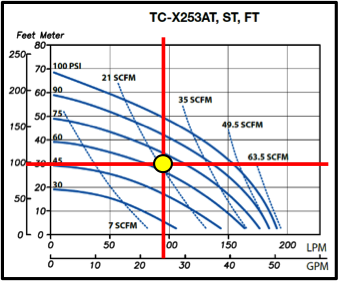Reading and Understanding AODD Pump Curves – Part of the Prescription
I have always used the work “prescribe” rather than suggest or recommend an AODD model for an application. Just as when you go to the doctor and they diagnose your ailments they ask a series of questions and take a series of measurements or readings (weight, height, temperature, blood pressure) and then diagnoses your situation. Not that I am comparing what we do to a doctor but the process is the same. We ask, “What’s problem are you trying to solve (pump a fluid from point A to point B)?” and “What are your symptoms (high flow, low head, variable pressure)?” and then we have lots of tools at our disposal to diagnose the application and prescribe a solution. I will talk about chemical resistance and materials of construction, among other topics, in coming articles but for today, I would like to help you understand AODD pump curves and what information is available and based on the duty point, how we prescribe the pump model for the application.
A typical inquiry might include “I need to pump a runoff sump of rainwater (their problem we are going to solve) up 100 feet to a storage tank and would like to do it at about 25 Gallons Per Minute (the symptoms of their application)”. Notwithstanding the need to evaluate materials of construction based on chemical compatibility and the fluid characteristics, we would like to the pump curves to see what size or series of pump we would need to prescribe an appropriate solution. Based on the symptoms, a 3/4” metallic pump could be one of the options so I will use this curve based on where the duty point falls – most favorably in the middle or sweet spot of the curve (more to come on that later).
Based on the input received we find the head pressure in feet (100’) and then the requested flow (25 GPM) and where they intersect is the duty point. We would definitely prescribe this pump series (the Iwaki AIR TC-X253 Metallic Series) as the duty point is in the middle of the curve for best performance and parts life expectations.
Based on that duty point, when you follow the solid blue line back up and to the left, you will see it is about half-way between the 60 and 75 PSI lines – so you would need about 68 PSI inlet air pressure to the pump to get it to perform at the required duty rate. Secondly, when you follow he dotted blue line upwardly, you see it is just a smidge over 21 SCFM so we would say you need at about 25 SCFM from your compressor to meet the requirements of the required duty point. If you missed my previous article about PSI vs. SCFM you can go here to review (LINK).
Hope this helps but remember that the pump curve is but one tool in the pump selection process – more to come on those tools in the very near future.
#IwakiAirAODD #ChooseAODD #ReasonsWhyAODD #AODDSelection www.IwakiAir.com



Follow Us On